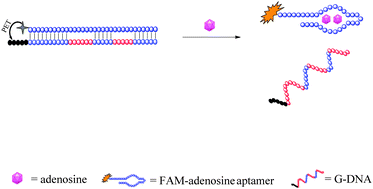A simple adenosine fluorescent aptasensor based on the quenching ability of guanine
Abstract
Based on

* Corresponding authors
a
Key Laboratory of Chemical Biology and Traditional Chinese Medicine Research (Ministry of Education), College of Chemistry and Chemical Engineering, Hunan Normal University, Changsha 410081, PR China
E-mail:
zhangyy@ hunnu.edu.cn, zhangyy0101@126.com
Fax: +86-731-8865515
Tel: +86-731-8865515
b Guangxi Nanning Senior School of Technology, Nanning 530031, PR China
Based on

 Please wait while we load your content...
Something went wrong. Try again?
Please wait while we load your content...
Something went wrong. Try again?
X. Fan, F. Lin, Y. Zhang, J. Zhao, H. Li and S. Yao, New J. Chem., 2012, 36, 2260 DOI: 10.1039/C2NJ40501F
To request permission to reproduce material from this article, please go to the Copyright Clearance Center request page.
If you are an author contributing to an RSC publication, you do not need to request permission provided correct acknowledgement is given.
If you are the author of this article, you do not need to request permission to reproduce figures and diagrams provided correct acknowledgement is given. If you want to reproduce the whole article in a third-party publication (excluding your thesis/dissertation for which permission is not required) please go to the Copyright Clearance Center request page.
Read more about how to correctly acknowledge RSC content.
 Fetching data from CrossRef.
Fetching data from CrossRef.
This may take some time to load.
Loading related content
